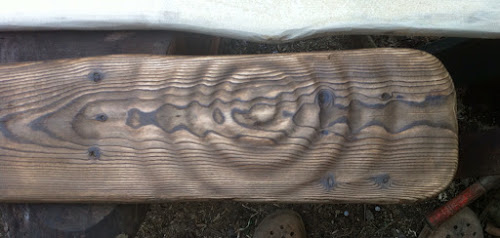Woodworks
 |
| Top rail for stairway |
I have recently taken to doing searches on Pinterest rather than google, there seems to be a feathering out of results which includes items I would not have thought of. Some of the time it is random pictures of cute kittens, which are sometimes amusing, but a recent search brought up images of wood surfaces carved by a CNC machine working off of some kind of algorithm. The watery effect was pretty nifty, so I thought I would impose something similar on this top rail for a soon to be built house. I don't have the technology to do CNC, but I do have a small belt sander, which I am quite friendly with. Initially I was just going to have the corner block rippled, but I couldn't stop and drew out more ripples onto the rail and had at it. The wood was then scorched and brushed back to enhance the grain. I will stain and polish next, even the raw finish is pretty effective. I may have to study a few ripple box images and work on expanding the idea to include more reactivity.





